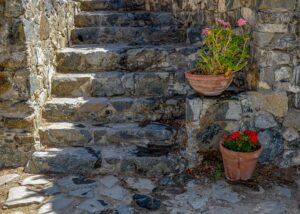A flagstone patio's condition should be carefully evaluated for restoration needs. This involves inspecting for physical damage like cracks or erosion, particularly in the joints between stones, and assessing overall appearance, texture, levelness, and drainage effectiveness. Pay attention to signs of algae, moss, or lichen, which can trap moisture and expedite deterioration. For successful restoration, prepare by gathering the right tools: a mason's hammer, safety gear, brooms, brushes, a cement or concrete mix, polymeric sand designed for flagstone, a garden hose or sprayer, an outdoor sealant, and a notched trowel. The use of these materials ensures proper repair and long-term durability against environmental factors. Applying a sealant protects the patio from future damage. By following these steps and using appropriate materials, homeowners can effectively restore their flagstone patio, significantly extending its lifespan and maintaining its aesthetic appeal for an enduring outdoor space enjoyment. Regular maintenance is key to minimizing future restoration needs.
Restoring a flagstone patio to its former glory can be a rewarding DIY project. Over time, weather elements and foot traffic can take their toll on these natural stone surfaces. This comprehensive guide on ‘Flagstone Patio Restoration’ covers everything from evaluating your patio’s condition to applying protective sealants. You’ll learn the essential steps for cleaning, identifying common issues, resurfacing worn areas, realigning and leveling slabs, and filling gaps with durable materials. Additionally, we’ll discuss maintenance strategies to keep your patio looking pristine and provide guidance on when professional assistance is necessary. Whether you’re dealing with minor discoloration or significant damage, this article equips you with the knowledge to tackle your flagstone patio restoration confidently.
- Assessing the Condition of Your Flagstone Patio
- Gathering the Necessary Tools and Materials for Restoration
Assessing the Condition of Your Flagstone Patio

Assessing the condition of your flagstone patio is a critical first step in any restoration project. Over time, exposure to the elements can take its toll on flagstone surfaces, leading to wear, moss growth, and even structural shifts that affect stability and aesthetics. Begin by visually inspecting the entire area for visible signs of damage such as cracks, chipping, or erosion. Pay particular attention to joints between stones, as these can deteriorate and compromise the integrity of the patio. Note any areas where the stone has shifted; this could indicate a need for re-bedding or pointing.
For a more thorough evaluation, consider the following aspects: the overall appearance, texture, levelness, and drainage of your flagstone patio. If algae, moss, or lichen have taken hold, not only do they detract from the patio’s visual appeal but they can also retain moisture against the stone, exacerbating wear over time. Evaluate the drainage by observing where water flows during rainstorms or after watering. Ideally, water should not pool on the surface, as this can lead to further damage. If you detect any of these issues, flagstone patio restoration might be necessary to preserve the functionality and beauty of your outdoor space. Engaging in regular maintenance can extend the lifespan of your patio and reduce the extent of future restorative work required.
Gathering the Necessary Tools and Materials for Restoration

When embarking on a flagstone patio restoration project, having the right tools and materials is paramount for achieving a successful outcome. The process begins with a thorough assessment of the existing flagstone condition to determine the extent of repair needed. Key tools such as a mason’s hammer or chisel, safety glasses, gloves, a broom, and a stiff brush are essential for removing loose stones, debris, and moss that can accumulate over time. A cement or concrete mix, depending on the type of bond desired, will be needed for resetting any dislodged stones. For deeper cracks or joint repairs, a polymeric sand mix specifically designed for flagstone patios is recommended to ensure a durable and weather-resistant seal. A garden hose or sprayer can aid in cleaning and applying sealants evenly across the surface. Additionally, a high-quality sealant suitable for outdoor use will protect the flagstones from future weathering and staining. It’s also wise to have a notched trowel on hand for applying the polymeric sand into the joints once the stones are secure. By gathering these materials and tools, you’ll be well-equipped to restore your flagstone patio to its former beauty and longevity, ensuring it can withstand the elements and continue to serve as a comfortable and attractive outdoor space for years to come.
Revitalizing a weathered flagstone patio can significantly enhance your outdoor living space, transforming it into a welcoming and aesthetically pleasing area. By carefully assessing the condition of your flagstone patio and equipping yourself with the right tools and materials for restoration, as detailed in this guide, you can achieve professional-level results. The process not only refreshes the appearance of your patio but also extends its longevity. For those committed to maintaining their outdoor spaces, flagstone patio restoration is a rewarding endeavor that combines the practical with the beautiful.
